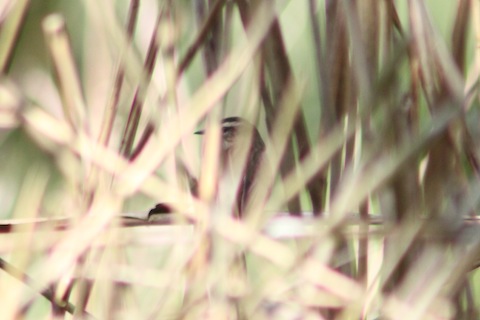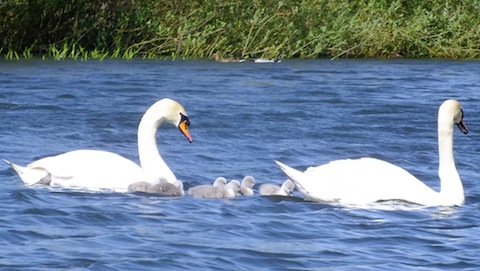- Stay Connected
 Abraham Lincoln
If given the truth, the people can be depended upon to meet any national crisis...
Abraham Lincoln
If given the truth, the people can be depended upon to meet any national crisis...
 Guildford news...
for Guildford people, brought to you by Guildford reporters - Guildford's own news service
Guildford news...
for Guildford people, brought to you by Guildford reporters - Guildford's own news service
Birdwatcher’s Diary No.3
Published on: 1 May, 2012
Updated on: 1 May, 2012
[thethe-image-slider name=”Birdwatcher’s Diary 3″]
Words and pictures by Malcolm Fincham
Saturday, April 21: Despite the inclement weather of late, I decided to take the chance of getting a soaking by going for a cycle once again down to Stoke Meadows to see if any more vistors had arrived, on what I suppose I should call my ‘local patch’.
Wasn’t too disappointed even though it was just the one sedge warbler singing (with rare bursts) in its usual erratic voice in a reed bed by the lake. Despite much patience, I only managed the one, very shy, picture.
More noticable at Stoke over the last few weeks have been the regular sighting of common buzzards, especially over the Slyfield dump, often being mobbed by crows (and other corvids). I saw three today – one of which was missing several of its primary feathers. I even managed a few snapshots…
Also managed to get a few pictures of a reed bunting and a female blackcap, which I wrote about in a previous article. But, as yet, no luck getting a picture of the kingfisher I keep seeing doing ‘flybys’ in various locations on my visits here.
Sunday, April 22: Could not believe my fortune this morning at Stoke meadows, especially after the report I submitted last night to the editor! For five years I have been taking a camera with me on most of my birdwatching trips and in all that time have never had the oppotunity of of getting anywhere near to taking a reasonable shot of a kingfisher.
However, I just happened to stumble apon this beauty. This is, I believe, a female. Male and female kingfishers are different (dimorphic is the term) and the male’s beak is black and doesn’t show any orange.
I also observed two common buzzards rise up from Slyfield and fly overhead in a south-east direction across the lake. But no sign of any new arrivals to the area. But you can imagine my delight to add the kingfisher to my day list.
Tuesday, April 24: Making the most of a reasonable, but still not very warm, day’s weather, I took a late afternoon cycle down to Stoke Meadows. Not much new to report apart from a little egret which was an unusual sight for me at this time of the year.
On the main lake were a few of what have become quite regular sightings in and around the Stoke and indeed the Guildford area – the Egyptian goose. These are, as may be guessed by the name, non -indigenous. They were introduced into this country in the 18th century as ornimental birds, but now breed in the wild, often in trees. They are now on the official British list of birds.
Earlier in the day I was pleased to pick out my first swift of the year among many house martins and swallows feeding on insects over Unstead Sewage works.
Wednesday, April 25: Other non-indiginous wildfowl now on the British species list that can often be viewed at Stoke Lake and surounding areas are large numbers of Canadian geese. Occasionally mandarin ducks can be seen both on the lake and the river. The male is far more colourful than the female.
Thursday, April 26: Having taken a day off from visiting Stoke Lake yesterday, due to the deluge of rain that was falling, I made the most of a much improved, though very breezey, afternoon to see if I could spot any new arrivals.
Unfortunately, any birds that may have arrived must hve been keeping a very low profile as even the blackcaps were struggling to put in a full melody.
The water levels had certainly risen in both the river and lake. My thoughts went out to all the birds that will be nesting in areas that had now become flooded.
Things were not looking good for the great crested grebes nesting out on the lake as they had appeared to have abandoned their nest which looked to be partly submerged.
There had been a brief visit by a kingfisher at the lake and I wondered if they may have been affected in the same way as they will nest in river banks well away from the main canal where most of the flooding was occurring.
Fortunately, as the year is still young, all these birds will be capable of having at least one, if not two, more broods ths year. However, to finish on a happy note it was pleasing to see that the swans which had been nesting on the island of the main lake were now the proud parents of six young cygnets, which, so I was informed, were being shown off for the first time today.
Sunday, April 29: Great weather for ducks and swans, but not a lot else. Friday had looked quite promising (once the rain cleared) as I noted the first swifts over my Guildford home. They seem to appear every year within a day or two of April 27. Unfortunately, from then on the weekend became quite a washout.
Dodging the showers, I decided to visit Stoke Meadows for a few hours this afternoon hoping to find a few birds still brave enough to show themselves. All of the cygnets were still all being well cared for by their parents and didn’t appear to be bothered about me getting some close-up pictures.
Several house martins had now joined the swallows skimming over the lake along with at least two swifts. Not much in the way of bird song, apart from a male reed bunting giving itself away and allowing me to take a few photos.
















Steve Balchin
May 4, 2012 at 6:21 pm
I think the birdwatcher is marvellous, I can’t wait for the next installment.